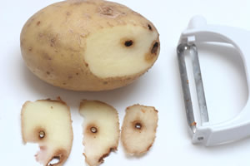
Wireworm populations are on the increase and causing high levels of damage to potato crops. A survey of growers using the Nemathorin Pheromone Traps last year reports an early warning of potential wireworm activity gives time to take action. All will be using the traps again this year, to monitor numbers of click beetles hatching from wireworm larvae.
Thousands of tones of potatoes coming out of stores are discarded from premium pre-pack grade because of the effects of wireworm. With skin finish the absolute priority in the eyes of the consumer, visible holes from wireworm feeding can be sufficient to downgrade samples.
For most packers, and even many processors, any damage greater than three peels deep will effectively consign samples to low-value processing or stockfeed. With escalating costs of waste disposal from processing plants, factory managers can not afford the time or charges for deep peeling or scrubbing.
"With generally milder winters soils are coming to life with greater insect activity," reports Syngenta Potato Manager, Alison Pawson. "All soil-borne pests appear to be on the increase, and pose a threat to potato crop yields and quality. Any soil pest damage instantly reduces the storability and marketability of the crop and the ability to supply quality samples throughout the year."
Wireworm is causing serious damage in areas where, hitherto, they have been unheard of; one grower in the Scottish borders reported significant losses last year, having never seen evidence of any attack in the past. Arable wireworm is now endemic across eastern counties and parts of Yorkshire, as well as the historically high risk western counties.
A Syngenta survey of potato growers using the Nemathorin Pheromone Traps last year, to identify wireworm risks, reported over 95% of users found the results useful in decision making for cropping choices and nematicide use. All of them will be using the traps again this season.
"Growers intentions reported by the survey clearly show they are considering a more integrated approach to pest management," according to Mrs Pawson. "In some instances where very high click beetle counts indicated a large numbers of wireworm larvae remain in the soil, (6% of fields trapped), growers have opted not to crop potatoes.
"In lower risk fields, many growers are going to apply Nemathorin at planting and/or plant with crops that that can be lifted earlier to minimise damage. Early warning of potential problems allows time for decision making to reduce damaging effects."
Pest management tool
Mrs Pawson highlights that the very high levels of adults often caught - up to 375 in one case - gave concern that the thresholds for treatment were too conservative. However, the traps did allow growers to compare the risk between fields - with counts from low as 10 to over 240 recorded on different fields across the same farm - demonstrating their potential as an Integrated Pest Management tool.
"Potato growers in the future are going to need to be more adept at managing the problem through a combination of Integrated Pest Management and effective targeting of nematicides," she advises.
Andrew Nottage, manager of Russell Smith Farms, Duxford near Cambridge, believes the pheromone traps have given a good indication of potential risk, when used in conjunction with bait trapping and field observations of wireworm, through digs and soil sampling.
"We welcome any initiative that enables us to identify potential risk early and make better decisions, but it has to be balanced against the practicality of fitting in with the farm rotation, variety choice and, ultimately, the need to produce consistent high quality potatoes."
With the help of the traps he was able to highlight one field where high beetle counts postponed planting this season, along with another where the trap results - in conjunction with no history of previous damage - indicated safe cropping with King Edwards without treatment. Results for other fields indicated Nemathorin treatment was justified, with one field identified for early lifting, by the end of August.
Mr Nottage will be repeating Nemathorin Pheromone Trap use this season, delegating responsibility to a trained student to ensure reliable and regular collection of data through the important May to July season.
Trapping advice
ADAS wireworm expert, Dr Bill Parker, who has pioneered the pheromone trapping technique in the UK, reports the traps use capsules of sexual attractant to lure male click beetles that have emerged from wireworm larvae through the spring and summer breeding season. Results of beetle numbers caught by the traps provide an estimate of larvae numbers remaining in the soil, and hence the risk of damage to potatoes.
Dr Parker advises the traps should be placed this year in fields destined for potatoes in 2007. Traps should be placed out at the end of April, in time for peak wireworm hatch and beetle activity in mid to late May. Traps, operated in sets of three, should be monitored and recorded weekly, with the pheromone capsule replaced every 30 days.
Pheromone trapping is claimed to be more effective at identifying wireworm presence than either bait trapping or soil sampling, although he recommends these techniques are used as a back-up to pheromone traps, particularly to verify positive click beetle catch results.
Growers can no longer assume a long break from the traditional grass host of wireworm infers safety from attack. Arable rotations are increasingly susceptible, with more grass weeds, field margins and set-aside all blamed for the increase in wireworm populations.
Furthermore, wireworm activity appears to be increasingly prevalent in the spring – possibly as a result of milder winters. Potato agronomists now report damage being commonly seen on salad crops and early set-skinned crops from mid-June onwards, where skin quality is paramount.
